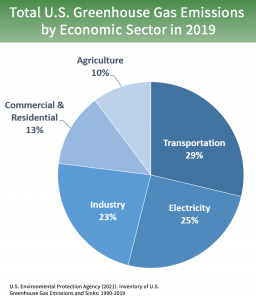Hundreds of organizations across the US are pledging to reduce their carbon emissions. According to NPR, more than 300 businesses have signed an open letter calling on the Biden administration to reduce greenhouse gas emissions in the United States to at least half of 2005 levels by 2030. That would nearly double a previous target set by former President Barack Obama in 2015, who pledged a 25 to 28% reduction by 2025.
However, you may be wondering what carbon emissions are and why are they important? Let’s start with the basics.
What is Carbon?
Carbon Dioxide or CO2 is a greenhouse gas that consists of one part carbon and two parts oxygen. It is one of the most important gases on the earth because plants use it to produce carbohydrates in a process called photosynthesis.
You have probably heard of CO2 emissions in the news regarding global warming. As CO2 builds up in our atmosphere from burning fossil fuels, it has a warming effect that can change the earth’s climate.
How does Carbon Get into the Atmosphere?
Atmospheric carbon dioxide comes from two primary sources—natural and human activities. Natural sources of carbon dioxide include most animals, which exhale carbon dioxide as a waste product. Human activities that lead to carbon dioxide emissions come primarily from energy production, including burning coal, oil, or natural gas.

Figure 1: Total Emissions in 2019 = 6,558 Million Metric Tons of CO2 equivalent. Percentages may not add up to 100% due to independent rounding.
* Land Use, Land-Use Change, and Forestry in the United States is a net sink and removes approximately 12 percent of these greenhouse gas emissions, this net sink is not shown in the above diagram. All emission estimates from the Inventory of U.S. Greenhouse Gas Emissions and Sinks: 1990–2019.
Source: https://www.epa.gov/ghgemissions/sources-greenhouse-gas-emissions
Over time, human activities and industries have been increasing the atmospheric concentrations more quickly than natural activities. The good news is that there are solutions including carbon sequestions.
What is Carbon Sequestration?
Carbon sequestration is the process of capturing and storing atmospheric carbon dioxide. It is one method of reducing the amount of carbon dioxide in the atmosphere with the goal of reducing global climate change. For agriculture, adopting regenerative farming practices such as cover cropping, and reduced tillage farms can reduce carbon emissions.
At CIBO, we support enterprises that are looking at the agriculture elements in their supply chain to understand how to inset or offset their carbon emissions. CIBO Enterprise provides insetting and incentives programs that provide direct payments (or other incentives) to growers for their regenerative practices.
CIBO also provides access to carbon markets and allows grower-focused enterprises to offer their grower network efficient, transparent access to soil carbon markets, including CIBO Carbon. Programs like CIBO Carbon enable farmers to enroll their fields in carbon markets. Through simple enrollment processes, growers upload information about their land management practices, so that potential carbon credits can be calculated. After the cash crop for the growing season emerges and practices are validated, the carbon credits are listed for sale in the marketplace.
How CIBO Calculates Carbon Sequestration
CIBO Carbon Credits consist of three categories:
- Carbon that is sequestered in the soil
- The avoidance of carbon loss from the soil
- The avoidance of GHG emissions
How CIBO Calculates Carbon Credits
CIBO Carbon Credits are calculated by using the grower’s practices to simulate GHG emissions and soil carbon change on a field.
At CIBO, we believe in helping every grower connect with the land in a new way. Regenerative agriculture is part of the solution farmers are adopting to address sustainable farm management and promote long-term productivity and profitability. That’s why we’ve developed technologies that help farmers reap the benefits of improving the environment for all of us.
Whether you are a farmer looking to get paid for your practice or an organization looking to become carbon neutral, CIBO can help. Get started with CIBO Impact.



